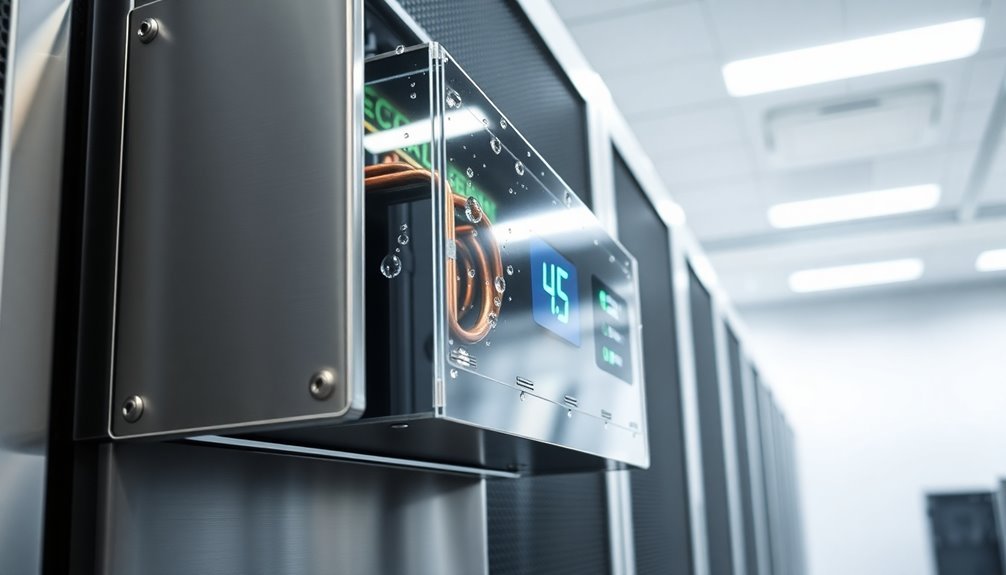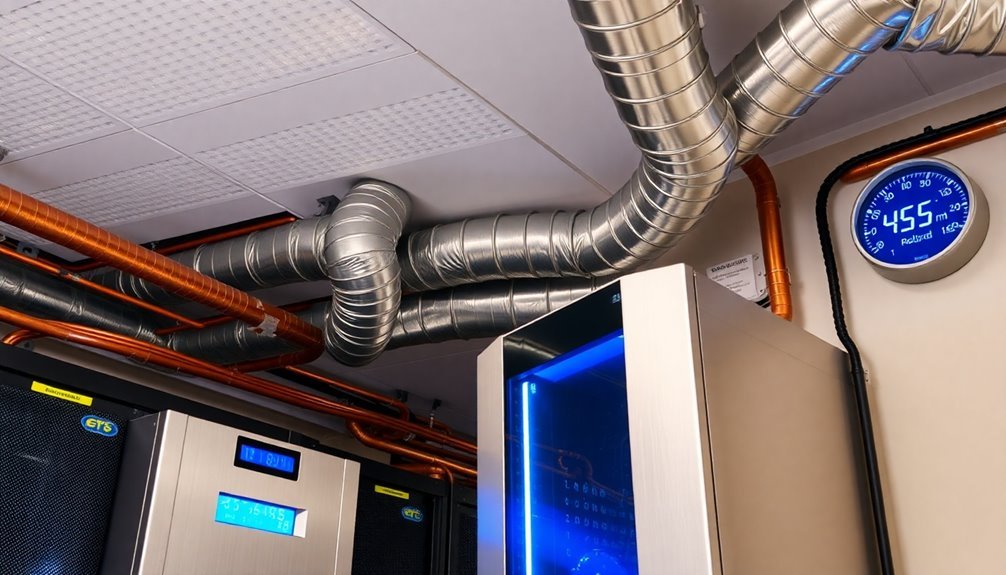Proper humidity control safeguards your electronic equipment in five essential ways. You'll prevent static discharge damage by maintaining 30-70% relative humidity levels. Your devices will operate at peak performance when you keep a stable 50% RH environment. You'll extend equipment life by avoiding moisture-related corrosion and component stress. Sensitive parts stay protected from both excess dampness and dangerous dry conditions that can cause failures. Regular monitoring and adjustment of humidity levels through dehumidifiers, air conditioners, and humidifiers guarantees the best protection for your valuable electronic investments. Understanding these protective measures can transform your equipment maintenance strategy.
Preventing Static Discharge Damage

With proper precautions, you can effectively prevent static discharge damage to electronic equipment. Maintaining proper humidity levels between 40-60% is essential, as this moisture content helps dissipate static charges naturally.
When you're handling sensitive components, you'll need to implement thorough ESD control measures in your workspace. Start by establishing a properly grounded workstation. You'll want to install ESD mats on your work surfaces and use wrist straps connected to a common grounding point.
When you're moving around the workspace, make sure you're wearing these straps correctly to discharge any static buildup from your body. Static electricity can accumulate up to 25,000 volts in the human body. Don't forget to store your components in anti-static bags or containers when they're not in use.
You'll need to eliminate common plastics and other high-charging insulators from your work area. Consider installing ionizers, which generate both positive and negative ions to neutralize static charges in the air.
If you're working in particularly dry conditions, you can use anti-static sprays to supplement your humidity controls. Remember to minimize unnecessary movement and friction when handling components, as these actions can generate unwanted static electricity.
Maintaining Optimal Operating Conditions
Maintaining ideal operating conditions for electronic equipment requires careful attention to humidity levels between 30% and 70% RH. You'll need to monitor these levels consistently, as they directly impact your equipment's performance and longevity.
For many manufacturing environments, maintaining a steady 50% relative humidity provides the best conditions for electronic components. Walking across vinyl floors can generate up to 12 kV of static at low humidity levels of 20% RH.
You'll face serious risks if you don't control humidity properly. High moisture levels can cause rust, corrosion, and condensation on circuit boards, potentially leading to short circuits and device failures. Temperature fluctuations from excessive humidity can also cause overheating problems that damage your equipment.
To maintain the best conditions, you'll want to implement several control methods. Install dehumidifiers and air conditioners to stabilize humidity levels, and use hygrometers to monitor the environment regularly.
For storage areas, place silica gel packs in equipment cases to absorb excess moisture.
Don't forget to conduct regular site assessments and document your humidity control measures to comply with industry regulations. You'll need to account for seasonal variations and your facility's layout when designing your humidity control strategy.
These steps will help protect your electronic equipment and maintain consistent production yields.
Extending Device Service Life

To extend your electronic equipment's service life, you'll need to implement thorough environmental controls that address humidity, temperature, and contamination risks. You should maintain humidity levels between 30-50% RH and keep temperatures stable to prevent component wear and system failures. Consider implementing preventive maintenance plans to ensure optimal system performance over time.
You can protect your equipment by installing commercial dehumidifiers and ensuring proper ventilation throughout your facility. Don't forget to use desiccants or silica gel packs as an additional safeguard against moisture buildup.
Regular powering up of idle devices will help dissipate any accumulated moisture that could otherwise damage sensitive circuits.
You'll need to focus on contamination control as well. Remove dust regularly from heat sinks and filters, as these particles can substantially reduce your equipment's lifespan. If you've experienced a loss event, don't hesitate to invest in professional decontamination services to restore your devices to their original condition.
Make sure you're consistently monitoring and maintaining your humidity control systems through regular servicing and calibration. By combining these protective measures, you'll create a prime operating environment that maximizes your electronic equipment's reliability and longevity.
Safeguarding Sensitive Components
Electronic components require precise storage and handling protocols to prevent damage from moisture and static electricity.
You'll need to maintain warehouse conditions at 23℃ (±3℃) with humidity levels between 30% and 40% RH. Store your components in vacuum-sealed bags with desiccant or in drying chambers where humidity stays below 10% RH.
When you're handling components, you must follow strict ESD guidelines. Ground your storage racks, and don't forget to check humidity-sensitive cards when opening packages. If you've opened packages, they'll need tracking cards to verify sealing dates. You shouldn't expose components for more than 5 hours – if production stops, return them to dry storage immediately. Components that exceed exposure limits may require baking in ovens to remove excess moisture.
To protect sensitive components, you'll want to implement thorough humidity control measures. Use humidifiers to maintain 40% RH, which helps safely dissipate static charges.
You should also install real-time monitoring systems that can dynamically adjust humidity levels. Don't overlook the importance of dry box monitoring and proper MSL compliance.
These measures work together to prevent condensation, minimize static buildup, and safeguard your components so they remain in ideal condition throughout the manufacturing process.
Minimizing Equipment Failure Risk

Building on proper component protection, you'll need targeted strategies to minimize equipment failure risks in your facility. You can substantially reduce failures by maintaining humidity levels at 40% RH while implementing thorough monitoring systems. Using dehumidifiers and air conditioning units will protect your equipment from moisture damage, while humidifiers help prevent dangerous ESD events. Regular maintenance helps identify early signs of tribocharging from friction between components.
| Risk Factor | Impact | Prevention Strategy |
|---|---|---|
| Static Buildup | Component Failure | Install Humidifiers at 40% RH |
| Excess Moisture | Corrosion | Deploy Dehumidification Systems |
| Temperature Fluctuation | Condensation | Maintain Stable Air Conditioning |
| Poor Monitoring | Delayed Response | Install Real-time Sensors |
| Environmental Changes | Performance Loss | Implement Dynamic Controls |
You'll want to integrate your climate control systems with real-time monitoring and predictive maintenance capabilities. This approach lets you spot potential issues before they cause equipment failure. By tracking humidity data trends, you can adjust your controls dynamically based on production activity. Don't forget to regularly inspect and clean your equipment – it's essential for identifying moisture-related problems early. These preventive measures will help protect your investment and maintain consistent production quality.
Frequently Asked Questions
How Often Should Desiccant Packets Be Replaced in Electronic Storage Containers?
You'll need to replace silica gel packets every 3-6 months, while molecular sieve packets can last 12-18 months with proper regeneration. Check for color changes and moisture indicators to determine replacement timing.
Can High Humidity Levels Permanently Damage Electronics Even After Conditions Improve?
Yes, you'll find that high humidity can cause permanent damage to your electronics through corrosion, component deterioration, and altered electrical properties. These issues won't reverse themselves even after humidity levels return to normal.
What Are Signs That Humidity Control Systems Need Maintenance or Replacement?
You'll notice these key warning signs: unusual noises, inconsistent humidity readings, visible mineral deposits, musty odors, and poor performance. If your system shows multiple symptoms, it's time for maintenance or replacement.
Do Different Electronic Components Require Different Humidity Control Methods?
Yes, you'll need different humidity controls for various components. While moisture-sensitive parts require lower humidity, SMT applications need consistent levels, and ESD-sensitive components work best around 40% relative humidity.
Is Natural Ventilation Enough for Humidity Control in Residential Electronic Setups?
No, you can't rely solely on natural ventilation for residential electronics. You'll need additional methods like dehumidifiers or air conditioners to maintain ideal humidity levels, especially in basements or enclosed spaces with poor airflow.
In Summary
You'll gain significant benefits by implementing humidity controls to protect your electronic equipment. Not only will you prevent costly static discharge damage, but you'll also maintain ideal operating conditions and extend the lifespan of your devices. By safeguarding sensitive components and reducing equipment failure risks, you're making a smart investment in your electronics' future performance and reliability.





Leave a Reply